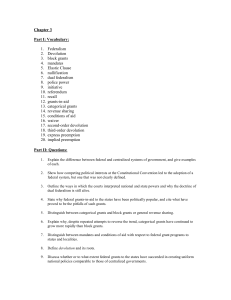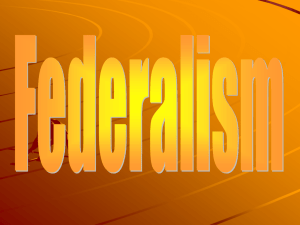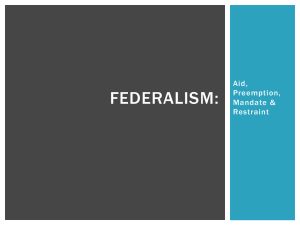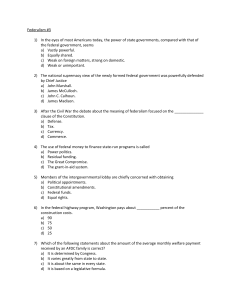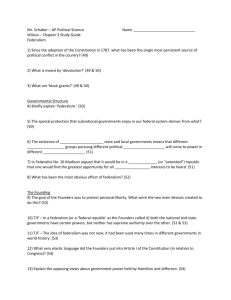Federalism
advertisement
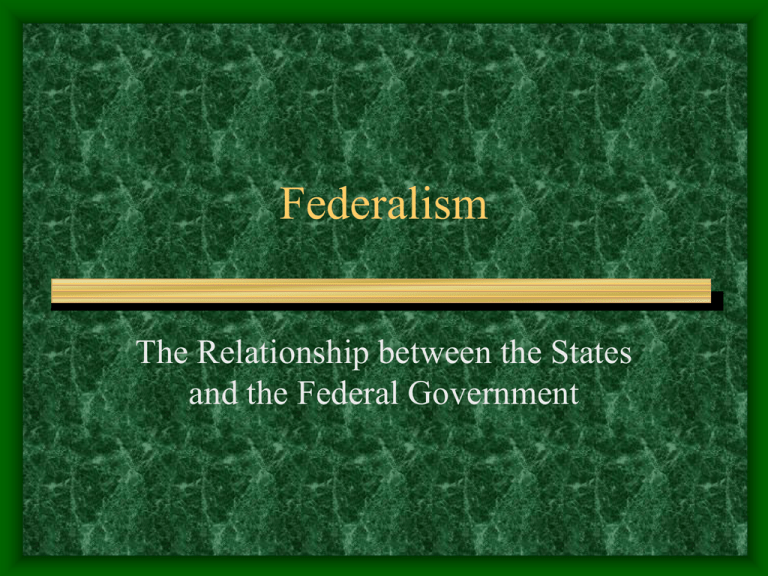
Federalism The Relationship between the States and the Federal Government Objectives • Define Federalism and compare to unitary and confederal forms of government. • 2) Identify and describe the importance for McCulloch v Maryland. • 3) What are the benefits of our federal system? • 4) How has the federal government gained power over the states? 1) • • • Identify and describe mandates, direct orders, crosscutting requirements, cross-over sanctions, preemption, block grants and project grants. How has each affected the balance of power between the federal government and the states? 6) Identify state responsibilities versus federal responsibilities. 7) How much do individuals trust the federal government versus the state government? What is the reason for that? 5) 3 Forms of Government • Unitary • Centralized • Little to no delegate of • • • • • • power to the localities. Confederal (Confederate) Loose Alliance of Independent States States are Sovereign Federal Power is shared between States and Central Gov’t Power is delegated to localities (Dillon’s Rule) Benefits/ Consequences of Federalism • • • • • Benefits; Flexibility Strength Higher political activity Lowers the cost of politics. • Local solutions/local problems • National solutions/national issues • Consequences; • Can block progress (civil rights movement) • Promoted racism • Varying laws and enforcement of laws Balancing Act of Power • Who has more power? • Power has recently shifted from states to the national government • Political ideology of Presidents can influence these changes. Methods Fed has used to gain power. • Supremacy Clause • McCulloch v. • • • • Maryland Mandates (often unfunded) Cross-cutting requirements Cross-over sanctions. Preemption. How can the Federal Government th override states’ rights and the 10 Amendment? • Easy answer…. • MONEY MONEY MONEY • States depend of FREE money from the Federal Government. • Why? • Grants-in-aide Money and Federalism The Federal Government has access to more. • Federal government can • • • • print more money. Can borrow money easier. States compete with other states, so they like to keep taxes low National Gov raises money from Income taxes States raise money from license fees and property taxes. • Federal Government can raise more money in taxes • Control the Fed reserve • Borrow money to cover deficits. • States and localities can go bankrupt. (They have a credit rating just like citizens.) Fiscal Federalism • Money is the basis of the relationship between the States and the Federal Government. • The “Carrot and Stick” approach. • Grants in Aid. Carrot and Stick explained • The Carrots; • Grants in aid • Money paid from one level of government to another level of government to be spent for a purpose. • Types of Grants; • Categorical – grants given • • • • for specific purposes. (2 Types) Formula – distributed by a formula Project – competitive won for a specific purpose, usually through a federal agency. Block – grants for general purposes. Revenue Sharing – shared tax dollars “no strings attached” The Stick • The stick is Preemption • Removal of area of authority from a state to the federal government. • Example; Clean Air and Water acts of 1990 • These often take state authority and cost money in the form of unfunded mandates. • Partial Preemption. • Government establishes minimums for the states to uphold. • In this case states have to set and enforce the standards • 350 of these have been passed since ratification. • More than half have occurred in the last 20 years. The carrot and stick combined • In order for states to get the • • • • money they need, the must comply with the rules. Crosscutting requirements. Attached to all grants Pertain to nondiscrimination, environmental protection, labor standards, and public access to gov’t information. 60 Rules that “cut across” all grants. • Cross-over sanctions • Penalties in one area for an infraction in the other. • Example (Drinking age and highway money) • Cigarette advertising. How do states feel about this loss of power? What can they do? • They often complain that they are unfair, costly, and do not take local conditions into account. • Some states and localities get more federal money than others. • Why do they follow them? • Self-interest…..need that money. Balance of Power • It is clear that since the passage of the 16th Amendment the Federal Government has gained power over the states. • However, in the 1990’s many Americans showed a great deal of distrust in the Federal Government Compared to the states. Devolution/GOP Revolution. • In 94’ the GOP took over • • • • control of both houses of congress. Devolution – federal power sent back to states in the form of block grants (Welfare) 2nd Order Devolution (States to localities) 3rd order Devolution States to private firms.

